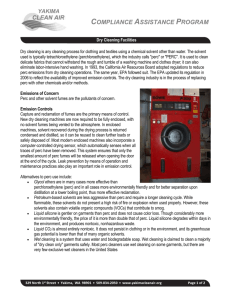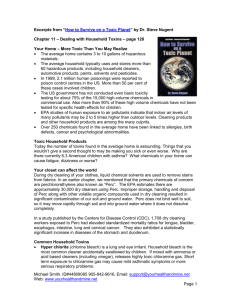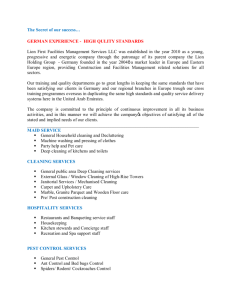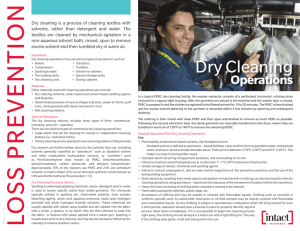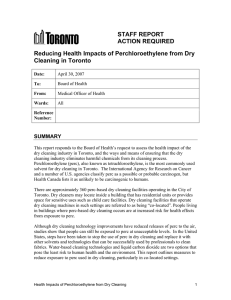Dry Cleaning - Worldwatch Institute
advertisement
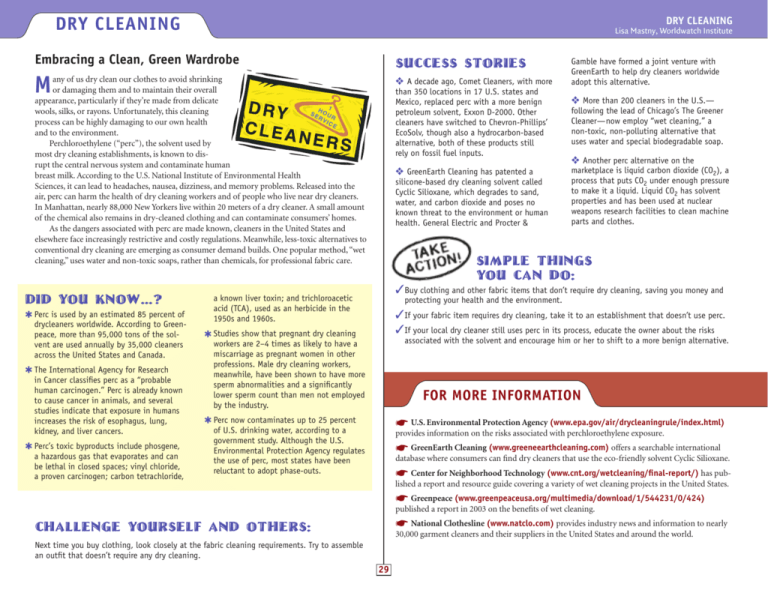
DRY CLEANING DRY CLEANING Lisa Mastny, Worldwatch Institute Embracing a Clean, Green Wardrobe Success stories M ❖ A decade ago, Comet Cleaners, with more any of us dry clean our clothes to avoid shrinking or damaging them and to maintain their overall appearance, particularly if they’re made from delicate wools, silks, or rayons. Unfortunately, this cleaning process can be highly damaging to our own health and to the environment. Perchloroethylene (“perc”), the solvent used by most dry cleaning establishments, is known to disrupt the central nervous system and contaminate human breast milk. According to the U.S. National Institute of Environmental Health Sciences, it can lead to headaches, nausea, dizziness, and memory problems. Released into the air, perc can harm the health of dry cleaning workers and of people who live near dry cleaners. In Manhattan, nearly 88,000 New Yorkers live within 20 meters of a dry cleaner. A small amount of the chemical also remains in dry-cleaned clothing and can contaminate consumers’ homes. As the dangers associated with perc are made known, cleaners in the United States and elsewhere face increasingly restrictive and costly regulations. Meanwhile, less-toxic alternatives to conventional dry cleaning are emerging as consumer demand builds. One popular method, “wet cleaning,” uses water and non-toxic soaps, rather than chemicals, for professional fabric care. Did you know…? ✱ Perc is used by an estimated 85 percent of drycleaners worldwide. According to Greenpeace, more than 95,000 tons of the solvent are used annually by 35,000 cleaners across the United States and Canada. ✱ The International Agency for Research in Cancer classifies perc as a “probable human carcinogen.” Perc is already known to cause cancer in animals, and several studies indicate that exposure in humans increases the risk of esophagus, lung, kidney, and liver cancers. ✱ Perc’s toxic byproducts include phosgene, a hazardous gas that evaporates and can be lethal in closed spaces; vinyl chloride, a proven carcinogen; carbon tetrachloride, than 350 locations in 17 U.S. states and Mexico, replaced perc with a more benign petroleum solvent, Exxon D-2000. Other cleaners have switched to Chevron-Phillips’ EcoSolv, though also a hydrocarbon-based alternative, both of these products still rely on fossil fuel inputs. ❖ GreenEarth Cleaning has patented a silicone-based dry cleaning solvent called Cyclic Silioxane, which degrades to sand, water, and carbon dioxide and poses no known threat to the environment or human health. General Electric and Procter & Gamble have formed a joint venture with GreenEarth to help dry cleaners worldwide adopt this alternative. ❖ More than 200 cleaners in the U.S.— following the lead of Chicago’s The Greener Cleaner—now employ “wet cleaning,” a non-toxic, non-polluting alternative that uses water and special biodegradable soap. ❖ Another perc alternative on the marketplace is liquid carbon dioxide (CO2), a process that puts CO2 under enough pressure to make it a liquid. Liquid CO2 has solvent properties and has been used at nuclear weapons research facilities to clean machine parts and clothes. Simple things you can do: ✓ Buy clothing and other fabric items that don’t require dry cleaning, saving you money and a known liver toxin; and trichloroacetic acid (TCA), used as an herbicide in the 1950s and 1960s. protecting your health and the environment. ✓ If your fabric item requires dry cleaning, take it to an establishment that doesn’t use perc. ✓ If your local dry cleaner still uses perc in its process, educate the owner about the risks ✱ Studies show that pregnant dry cleaning associated with the solvent and encourage him or her to shift to a more benign alternative. workers are 2–4 times as likely to have a miscarriage as pregnant women in other professions. Male dry cleaning workers, meanwhile, have been shown to have more sperm abnormalities and a significantly lower sperm count than men not employed by the industry. FOR MORE INFORMATION ✱ Perc now contaminates up to 25 percent ☛ U.S. Environmental Protection Agency (www.epa.gov/air/drycleaningrule/index.html) of U.S. drinking water, according to a government study. Although the U.S. Environmental Protection Agency regulates the use of perc, most states have been reluctant to adopt phase-outs. provides information on the risks associated with perchloroethylene exposure. ☛ GreenEarth Cleaning (www.greeneearthcleaning.com) offers a searchable international database where consumers can find dry cleaners that use the eco-friendly solvent Cyclic Silioxane. ☛ Center for Neighborhood Technology (www.cnt.org/wetcleaning/final-report/) has published a report and resource guide covering a variety of wet cleaning projects in the United States. ☛ Greenpeace (www.greenpeaceusa.org/multimedia/download/1/544231/0/424) published a report in 2003 on the benefits of wet cleaning. ☛ National Clothesline (www.natclo.com) provides industry news and information to nearly Challenge yourself and others: 30,000 garment cleaners and their suppliers in the United States and around the world. Next time you buy clothing, look closely at the fabric cleaning requirements. Try to assemble an outfit that doesn’t require any dry cleaning. 29

